Part 27: Wrapping Up
Editing 09.24.08
Editing 09.24.08
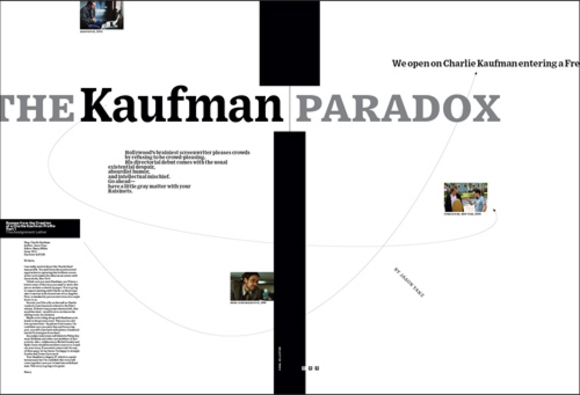
Design 09.24.08
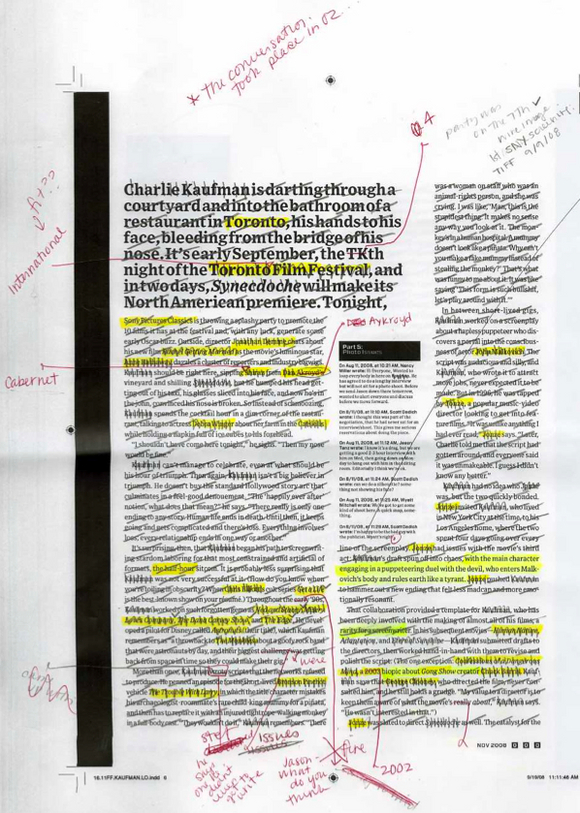
Editing 09.23.08
My job is to guard the facts, to double-check every statement and make sure no mistakes slip through. I started working on this after receiving Bob's edit, feeding the writer and editor a stream of updates and corrections throughout the process.… MORE
Editing 09.23.08
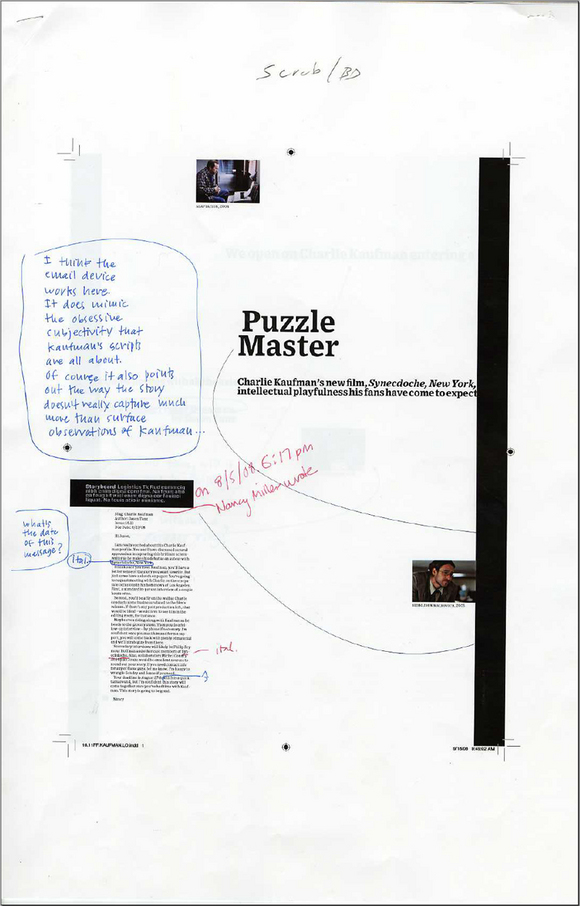
Editing 09.20.08
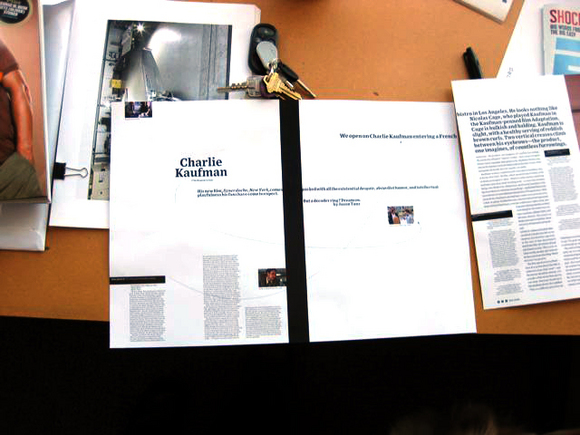
Design 09.19.08
Controversy 09.19.08
Photography 09.19.08
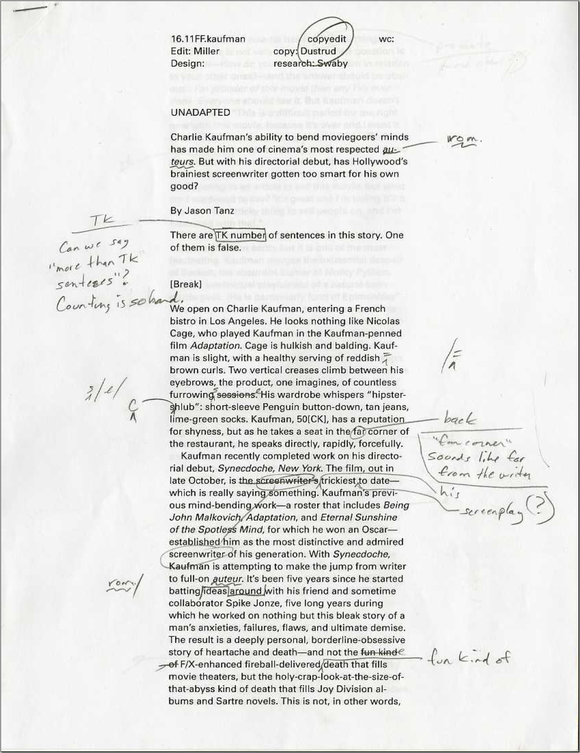
Editing 09.18.08
This is our first hardcopy stage. Every edit from here on in will be done mostly on paper, with proofs being handed back and forth from copy editors to researchers to editors. The story's main editor, Nancy Miller, is arbiter of which changes get rejected, which get integrated, and which require further study. As you'll see from my notes on the pages, the copy editor does more than check basic spelling and grammar. It's also my job to point out holes in the logic, imprecise turns of phrase, and other weaknesses, both minor and major, as I see them. And overuse of commas. Nancy then goes over these with the writer, if necessary, and gives it all back to me to enter into the electronic file.… MORE
Design 09.14.08
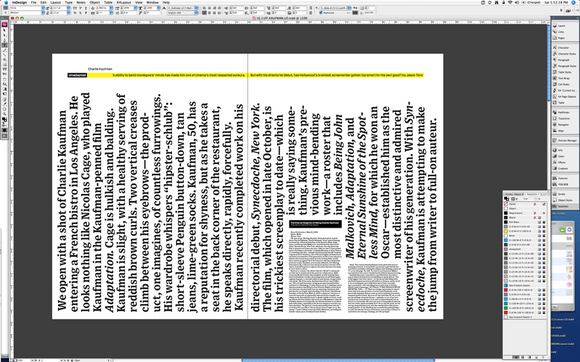
Design 09.13.08
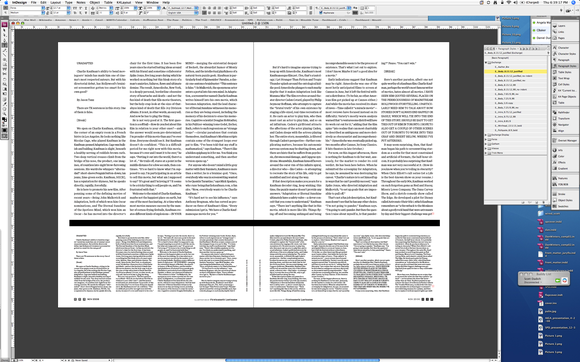
Design 09.13.08

Photography 09.12.08
From Anna Alexander:
While the publicist was waiting to hear back from Kaufman, I thought I'd start bringing in some additional artwork, "pick-up" in photo edit speak. You never know if the editors are suddenly going to want a movie time-line or a sidebar, and you don't want to be scrambling at the end. The Publicist had sent me a ton of screenshots from Sony Pictures Classics of Synecdoche, New York, which I logged into our Art Tracking database (every photo ever is onfile)- each image gets a name so we can keep track of them, like "16.11FF.kaufman.dl.55089." "16" is for the Wired year, "11" is November, "FF" is feature, "dl" = digital low resolution, and the last sequence of digits are the art tracking number. I know, fascinating. I then created a contact sheet for Scott and I to go over and make selects.
I also dove into some stock photography sites to see what was out there, just in case we're unable to get exclusive images and we need reference of Kaufman for an illustration. I started searching our usual suspects: Getty, Corbis, AP, etc. I've included a sample of what a stock search for Charlie Kaufman looks like from Getty Images.
Editing 09.12.08
Posted are two versions of our Kaufman story: My revise with Jason's comments/changes/challenges and then the clean version I put together for Wired's executive editor, Bob Cohn, to read.… MORE
Right now, I see this story as 85% finished. There are still a few TK's (shorthand for "to come") in need of filling but I'm thinking the piece looks pretty good. There are still a lot of steps to go: Bob's version, with his comments and questions (posting tomorrow), copy editing, fact-checking, art's layout, a process we have here called "scrub," but we'll get to that next week. For now, here's Jason's version and my final (for now) take, presented side-by-side for comparison.
Disclaimer: The piece will be fact-checked and copy-edited soon, but for now, this story, like the previous versions, may contain errors.
Photo Shoots 09.12.08
From deputy photo editor Anna Alexander:
… MOREI'm the photo editor on this experiment. I guess I'll fill you in on the juice of what happens next with the photo shoot attempts. First, I get the contact info for the subject from the editor. She gets it from the writer, and busts it back to me. My contact was Sony's publicist--he has requested I not reveal his name, so we'll call him The Publicist.
Contacting the subject for a photo shoot usually takes place somewhere between a green-lit pitch and the rough. I'm a bit late on my post, so it's not quite chronological. There's a reason I have a degree in photography, not literature.
I usually don't call contacts first if email is provided. If I don't hear back for a bit, I attack by phone. When I first wrote him, I mentioned that I was aware of Kaufman's "no photo shoot" stance, so I inquired about the possibility of doing a self-portrait.
Meanwhile, Scott remembered one of our senior editors, Adam Rogers, spending some time with the director Spike Jonze at a past Wired event. Spike Jonze and Charlie Kaufman worked together on Being John Malkovich, and Jonze was a photographer in his early days.
I'm not going to post any emails between The Publicist and I, but I will post my updates to Scott, Nancy, and Jason regarding any info on shooting Charlie.
Editing 09.10.08
Jason posted his rough draft yesterday. Now it's my turn to post my edit. This is what I sent back to him for his first revise. Here are a few things you might find interesting before you jump in:… MORE
As you can see from our previous posts, Jason and I discussed this story quite a bit before he actually interviewed Charlie Kaufman. After he met with Kaufman in LA, Jason seemed confident in the story he wanted to write. Those two factors have resulted in a solid rough draft. The structure works, most of the reporting is there (with a few holes to fill in from his Toronto Film Festival trip) and the writing is lively and smart, especially the ending--those last two graphs--are terrific.
Most of my comments and questions (all in italic) are up top. No big architectural work for me on this piece, just nitpicky, line-by-line stuff and a few suggestions here and there. I recognize with any story, some of my edit suggestions will work, others won't. You'll get to see what worked and what didn't the revise Jason kicks back to me and the subsequent polished version I send along to Wired's executive editor. His revise and that version will appear together in an upcoming post. Stay tuned...
DISCLAIMER: Like the rough draft, this edit has not been fact-checked or copy-edited so may/probably contain factual errors, typos, and other mistakes.
Writing 09.09.08
Filing a rough draft always makes me a little queasy, and this one was no exception. I always feel the urge to write a note to my editor explaining the choices I made, stuff to look out for, etc., but usually am able to resist -- really, the editor should be coming to this blind, like any reader would. But for the sake of transparency, and if you'll pardon a little (more) self-indulgence, here are a few of the elements that gave me the most trouble as I tried to write this thing:… MORE
1. Making Kaufman work for our magazine -- I live in fear of my editors reading this story and asking "What does this guy have to do with Wired?" Early on, I tried to focus on logic, mathematics, and paradoxes in Kaufman's films, as a way of answering that question before it's asked. We'll see if it works.
2. Striking the right balance -- To be honest, I'm an unabashed Kaufman fan. I also quite liked Synecdoche -- perhaps more than the average moviegoer would. (I've spoken to several who weren't as crazy about it, and a few who were.) I didn't want my fanboysihness to override the story; at the same time, there's an equally pernicious impulse to dump on something just to prove that you AREN'T a fanboy, and I didn't want to fall into that trap either. In the end, I decided that my own opinions about the movie didn't matter; the point is that the reception has been mixed, and Kaufman himself is quite openly anxious about the movie's prospects. That's the story, regardless of what I think.
3. Getting just a little clever -- Kaufman writes (sometimes) about the process of writing. So there was a temptation to do the same within the text of this piece. (To see how obnoxious that could have been, check out my pitch, which succumbed completely to this temptation.) Nancy agreed that I should write this fairly straight. But at the same time, circularity and
recursion were themes that I was addressing in the piece, and I tried to subtlely add a few recursive elements in the draft. It's hard to know when you're beating readers over the head, or when you're being so subtle that 99% will miss it entirely. I still have doubts about the "one of these sentences is false" intro, but left it in for now.
OK, enough yammering. Here's the damn draft. DISCLAIMER: THIS IS A FIRST DRAFT. IT HAS NOT BEEN FACT-CHECKED OR COPY-EDITED, SO MAY/PROBABLY DOES CONTAIN FACTUAL ERRORS, TYPOS, AND OTHER MISTAKES.
Photography 09.08.08
Writing 09.08.08
Photo Shoots 09.05.08
The Blogosphere 09.05.08

Reporting 09.04.08
Behind-the-Scenes 09.04.08
Ideas 09.02.08
On 8/4/08 12:18 PM, "Jason Tanz" <Jason_Tanz@wired.com> wrote:… MORE
OK, I know we're still not clear on whether this Kaufman story is even happening, but I had a thought over the weekend, and wanted to run it by you.